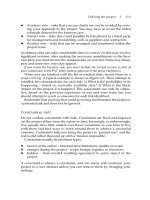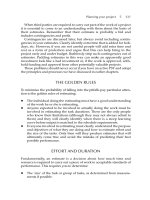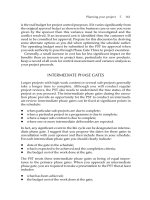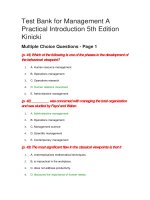Management a practical introduction 3rd kinicky chapter 14
Bạn đang xem bản rút gọn của tài liệu. Xem và tải ngay bản đầy đủ của tài liệu tại đây (492.58 KB, 36 trang )
Management
A Practical Introduction
Third Edition
Angelo Kinicki &
Brian K. Williams
Kinicki/Williams, Management: A Practical Introduction 3e ©2008, McGraw-Hill/Irwin
Major Questions
I don’t want to be just a manager, I want to be a leader—what’s
the difference between the two?
What does it take to be a successful leader?
Do effective leaders behave in similar ways?
How might effective leadership vary according to the situation
at hand?
What does it take to truly inspire people to perform beyond
their normal levels?
If there are many ways to be a leader, which one would most
likely describe me?
McGraw-Hill/Irwin
Kinicki/Williams, Management: A Practical Introduction 3e ©2008, McGraw-Hill/Irwin
2 © 2006 The McGraw-Hill Companies, Inc. All rights reserved.
Chapter 14: Power,
Influence, & Leadership
From Becoming a Manager
to Becoming a Leader
Wielding Influence
Trait Approaches
Behavioral Approaches
Contingency Approaches
The Full-Range Model
Six Additional Perspectives
Kinicki/Williams, Management: A Practical Introduction 3e ©2008, McGraw-Hill/Irwin
4
14.1 The Nature Of Leadership:
Wielding Influence
WHAT IS THE DIFFERENCE BETWEEN
MANAGERS & LEADERS?
Leadership is the ability to influence employees
to voluntarily pursue organizational goals
Managers and leaders are not one and the
same
Mangers have legitimate power to plan,
organize, and control
Leaders create a vision and strategic plan for
the company, which managers then implement
Kinicki/Williams, Management: A Practical Introduction 3e ©2008, McGraw-Hill/Irwin
5
14.1 The Nature Of Leadership:
Wielding Influence
Managers cope with complexity, while leaders
cope with change
Managers cope with complexity through:
-planning and budgeting
-organizing and staffing
-controlling and staffing
Leaders cope with change by:
-setting a direction
-aligning people
-motivating and inspiring
Kinicki/Williams, Management: A Practical Introduction 3e ©2008, McGraw-Hill/Irwin
6
Managers Vs. Leaders
Managers
Leaders
What needs to be done
— planning and
budgeting
Creating arrangements
of people to accomplish
an agenda — organizing
and staffing
Ensuring people do
their jobs — controlling
and problem solving
What needs to be done
— setting a direction
Creating arrangements
of people to accomplish
an agenda — aligning
people
Ensuring people do
their jobs — motivating
and inspiring
McGraw-Hill/Irwin
Kinicki/Williams, Management: A Practical Introduction 3e ©2008, McGraw-Hill/Irwin
7 © 2006 The McGraw-Hill Companies, Inc. All rights reserved.
14.1 The Nature Of Leadership:
Wielding Influence
WHAT ARE THE SOURCES OF
POWER IN AN ORGANIZATION?
Power is the extent to which a person is able to
influence others so they respond to orders
Personalized power is directed at helping
oneself
Socialized power is directed at helping others
Kinicki/Williams, Management: A Practical Introduction 3e ©2008, McGraw-Hill/Irwin
8
Five Sources of Power
1. Legitimate Power – influencing behavior
because of one’s formal position
All managers have legitimate power over their
employees; deriving from their positions
McGraw-Hill/Irwin
Kinicki/Williams, Management: A Practical Introduction 3e ©2008, McGraw-Hill/Irwin
9 © 2006 The McGraw-Hill Companies, Inc. All rights reserved.
Five Sources of Power
2. Reward Power – influencing behavior by
promising or giving rewards
all managers have; results from manager’s
authority to reward their subordinates
Rewards can range from praise to pay
raises
McGraw-Hill/Irwin
Kinicki/Williams, Management: A Practical Introduction 3e ©2008, McGraw-Hill/Irwin
10 © 2006 The McGraw-Hill Companies, Inc. All rights reserved.
Five Sources of Power
3. Coercive Power – influencing behavior by
threatening or giving punishment
All managers have; results from the
manager’s authority to punish their
subordinates
Punishment can range from verbal or
written
reprimands to demotions or
terminations
Must be used judiciously
McGraw-Hill/Irwin
Kinicki/Williams, Management: A Practical Introduction 3e ©2008, McGraw-Hill/Irwin
11 © 2006 The McGraw-Hill Companies, Inc. All rights reserved.
Five Sources of Power
4. Expert Power – influencing behavior
because of one’s expertise
Results from one’s specialized information
or expertise
Expertise, or special knowledge, can be
mundane or sophisticated
McGraw-Hill/Irwin
Kinicki/Williams, Management: A Practical Introduction 3e ©2008, McGraw-Hill/Irwin
12 © 2006 The McGraw-Hill Companies, Inc. All rights reserved.
Five Sources of Power
5. Referent Power – influencing behavior
because of one’s personal attraction
Power derived from one’s personal
attraction
Characterizes strong, visionary leaders
McGraw-Hill/Irwin
Kinicki/Williams, Management: A Practical Introduction 3e ©2008, McGraw-Hill/Irwin
13 © 2006 The McGraw-Hill Companies, Inc. All rights reserved.
14.1 The Nature Of Leadership:
Wielding Influence
HOW CAN YOU GET YOUR WAY AT WORK?
The ability to get others to follow your wishes is
influence
There are nine ways to try to influence others:
-rational persuasion - convincing someone by
using logic, reason, or facts
-inspirational appeals - building enthusiasm or
confidence by appeals to emotions, ideals, or values
-consultation - getting others to participate in a
decision or change
Kinicki/Williams, Management: A Practical Introduction 3e ©2008, McGraw-Hill/Irwin
16
14.1 The Nature Of Leadership:
Wielding Influence
-ingratiating tactics - acting humble or friendly
before making a request
-personal appeals - referring to friendship and
loyalty when making a request
-exchange tactics - reminding someone of past
favors or offering to make a trade
-coalition tactics - getting others to support your
effort
-pressure tactics - using demands, threats, or
intimidation
-legitimating tactics - basing a request on implied
support from superiors, or on rules or policies
Kinicki/Williams, Management: A Practical Introduction 3e ©2008, McGraw-Hill/Irwin
17
14.1 The Nature Of Leadership:
Wielding Influence
WHAT ARE THE DIFFERENT APPROACHES TO
LEADERSHIP?
There are five principal approaches or
perspectives on leadership:
1. trait
2. behavioral
3. contingency
4. full-range
5. six additional
Kinicki/Williams, Management: A Practical Introduction 3e ©2008, McGraw-Hill/Irwin
20
14.2 Trait Approaches: Do Leaders Have
Distinctive Personality Characteristics?
DO SUCCESSFUL LEADERS HAVE DISTINCTIVE TRAITS?
Trait approaches to leadership attempt to identify
distinctive characteristics that account for the effectiveness
of leaders
James Kouzes and Barry Posner proposed that the
personal traits that were looked for and admired in leaders
were honesty, competency, a forward-looking mentality, the
ability to inspire, and intelligence
Larry Bossidy, CEO of AlliedSignal, suggests that the four
qualities that are most important when he is interviewing
and evaluating job candidates are the ability to execute, a
career runway, a team orientation, and multiple experiences
Kinicki/Williams, Management: A Practical Introduction 3e ©2008, McGraw-Hill/Irwin
21
14.2 Trait Approaches: Do Leaders Have
Distinctive Personality Characteristics?
Timothy Judge did two meta-analyses (a
statistical pooling technique that permits
behavioral scientists to draw general conclusions
about certain variables from many different
leaders) on traits and leadership
Judge found that extroversion, openness, and
conscientiousness were all important to leadership
effectiveness
Judge also found that personality was more
important than intelligence for leadership
effectiveness
Kinicki/Williams, Management: A Practical Introduction 3e ©2008, McGraw-Hill/Irwin
22
14.2 Trait Approaches: Do Leaders Have
Distinctive Personality Characteristics?
Women tend to have more leadership traits
than men, but hold fewer leadership positions
CEOs believe this may be because women lack
significant general management experience, and
have not been around long enough to be selected
Women believe that male stereotyping and
exclusion from important informal networks
contribute to the problem
Other reasons may be because women are not
willing to compete as hard as men, or make the
necessary personal sacrifices
Kinicki/Williams, Management: A Practical Introduction 3e ©2008, McGraw-Hill/Irwin
23
14.3 Behavioral Approaches: Do Leaders
Show Distinctive Patterns of Behavior?
DO EFFECTIVE LEADERS BEHAVE IN SIMILAR
WAYS?
Researchers have studied behavioral leadership
approaches to determine the distinctive styles used by
effective leaders
The University of Michigan study identified two forms of
leadership:
1. Managers with job-centered behavior pay more
attention to job and work procedures
2. Managers with employee-centered behavior pay more
attention to employee satisfaction and making work
groups cohesive
Kinicki/Williams, Management: A Practical Introduction 3e ©2008, McGraw-Hill/Irwin
24
14.3 Behavioral Approaches: Do Leaders
Show Distinctive Patterns of Behavior?
The Ohio State model identified two major dimensions of
leader behavior:
1. Initiating structure is leadership behavior that organizes
and defines what group members should be doing
2. Consideration is leadership behavior that expresses
concern for employees by creating a warm, friendly,
supportive climate
From both studies, we know that effective leaders:
-have supportive or employee-centered relationships with
employees
-use groups rather than individual methods of supervision
-set high performance goals
Kinicki/Williams, Management: A Practical Introduction 3e ©2008, McGraw-Hill/Irwin
25
14.4 Contingency Approaches: Does
Leadership Vary With The Situation?
HOW DOES EFFECTIVE LEADERSHIP VARY
WITH THE SITUATION?
Proponents of the contingency approach to
leadership believe that effective leadership
behavior depends on the situation at hand
There are three contingency approaches:
1. The contingency leadership model, developed
by Fred Fiedler, determines if a leader’s style is
task oriented, or relationship oriented, and if that
style is effective for the situation at hand
Kinicki/Williams, Management: A Practical Introduction 3e ©2008, McGraw-Hill/Irwin
26
14.4 Contingency Approaches: Does
Leadership Vary With The Situation?
Once an individual’s leadership orientation is
known, you determine situational control (how
much control and leadership a leader has in the
immediate work environment)
There are three dimensions of situational control:
-leader-member relations - the extent to which a
leader has support, loyalty, and trust of the group
-task structure - the extent to which tasks are
routine, unambiguous, and easily understood
-position power - how much power a leader has
Kinicki/Williams, Management: A Practical Introduction 3e ©2008, McGraw-Hill/Irwin
27
14.4 Contingency Approaches: Does
Leadership Vary With The Situation?
Neither leadership style works all the time
The task oriented approach works well in high
control or low control situations
The relationship oriented approach works well
in moderate control situations
Kinicki/Williams, Management: A Practical Introduction 3e ©2008, McGraw-Hill/Irwin
28
14.4 Contingency Approaches: Does
Leadership Vary With The Situation?
2. The path-goal leadership model, developed by
Robert House, holds that the effective leader
makes desirable awards available to followers,
and increases their motivation by clarifying the
paths (behavior) that will help them achieve those
goals and providing them with support
House revised his theory to say that employee
characteristics and environmental factors cause
some leadership behaviors to be more effective
than others
Kinicki/Williams, Management: A Practical Introduction 3e ©2008, McGraw-Hill/Irwin
29
14.4 Contingency Approaches: Does
Leadership Vary With The Situation?
where: employee characteristics include locus of
control, task ability, need for achievement, experience, and
need for path-goal clarity, environmental factors include
task structure and work group dynamics, and leader
behaviors include path-goal clarifying, achievement
oriented, work facilitation, supportive, interaction
facilitation, group oriented decision making,
representation & networking, value-based
Further research is needed to determine how well
House’s revised theory holds up
However, we do know that it can be useful to have more
than one leadership style, and that leadership style should
be modified to fit employee and task characteristics
Kinicki/Williams, Management: A Practical Introduction 3e ©2008, McGraw-Hill/Irwin
30









